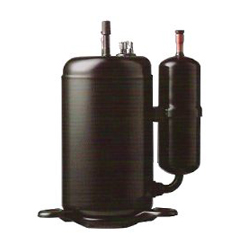Rotary vane compressors
 Rotary vane compressors consist of a cylindrical casing, two openings - one suction and one discharge - and a rotor positioned eccentrically with respect to the casing. Compression occurs by refrigerant flowing into the chamber where, due to eccentric rotation, there is a reduction in the desired volume.
Rotary vane compressors consist of a cylindrical casing, two openings - one suction and one discharge - and a rotor positioned eccentrically with respect to the casing. Compression occurs by refrigerant flowing into the chamber where, due to eccentric rotation, there is a reduction in the desired volume.
The advantages of rotary vane compressors are low cost and compact dimensions, making these the best choice for low capacity home applications (fridge-freezers, air conditioners).
Recently, rotary vane compressor technology (generically called “rotary”) has evolved through the introduction of “twin” compressors with two rotors revolving in counter rotating directions. These feature lower noise and generate less vibrations to a level that makes twin rotary compressors a good alternative often preferred to the more expensive and bulky scroll compressors.
Efficiency of twin rotary compressors is good, and higher compared to single rotary technology. Efficiency is also higher, on average over a wide operating range, than scroll compressors. This feature grants a wider range of applications, up to 50kW cooling capacity, making them suitable for the commercial and industrial markets.
The highest efficiency of rotary compressor technology is achieved when they are fitted with brushless DC motors and driven by inverters.
Currently BLDC twin rotary compressors have the highest ratio between cooling capacity and compressor size, and can reach up to 7,800 rpm maximum speed versus the 5,500-6,600 rpm usually achieved by scroll compressors.
Related Products and applications
| c.pCO sistema |  |
| pCO sistema |  |
| uC sistema |  |
| DC inverter |  |
| Chiller/Heat Pump units |  |
| CRAC |  |
| Heat Recovery Unit |  |
| Rooftop |  |
| Dryers |  |
| Temperature control units |  |
| HEOS Sistema |  |
| HECU Sistema |  |
| HECU CO2 |  |
Do you need more informations? KNOWLEDGE CENTER
KNOWLEDGE CENTER
